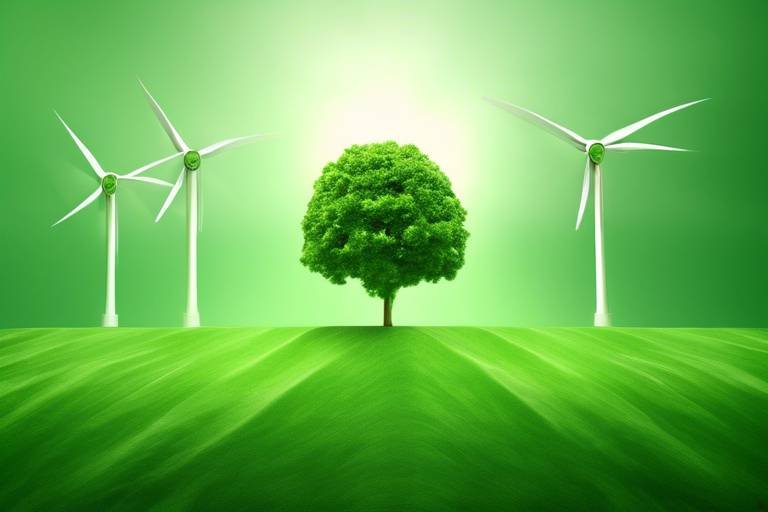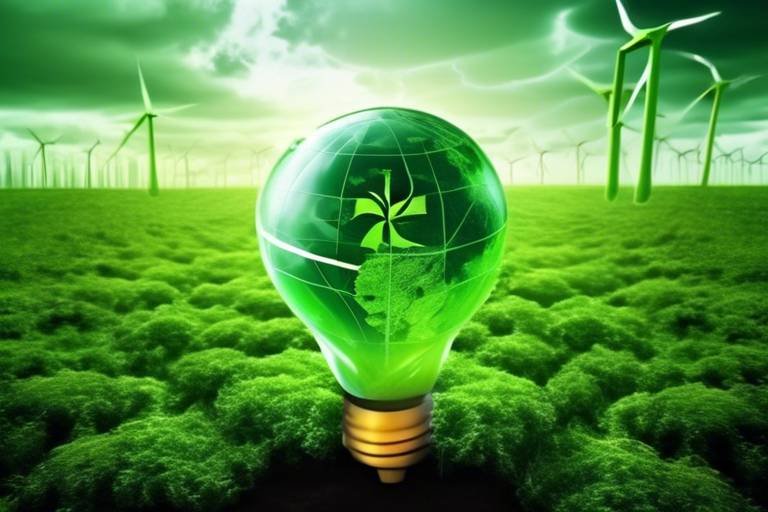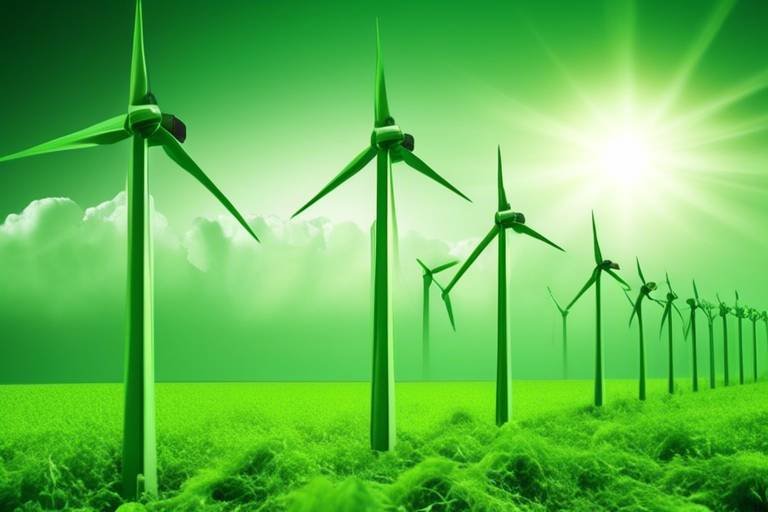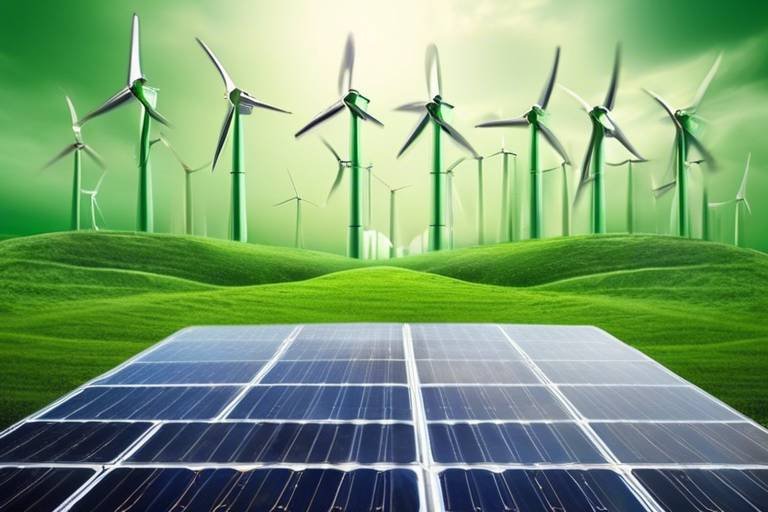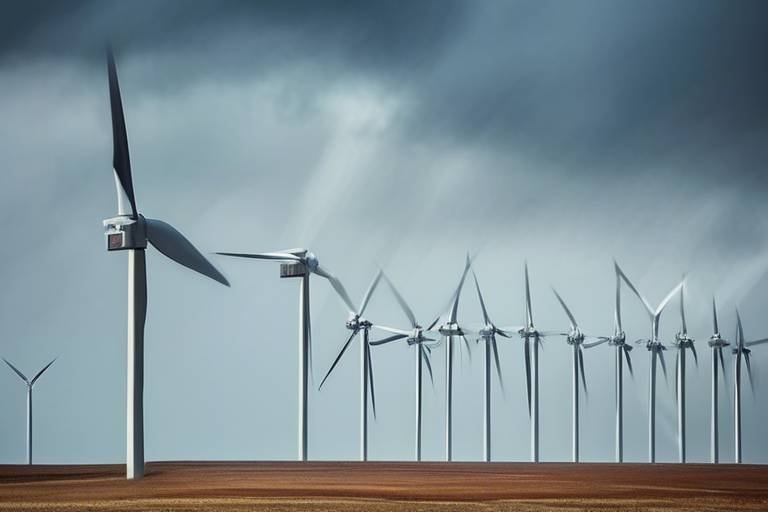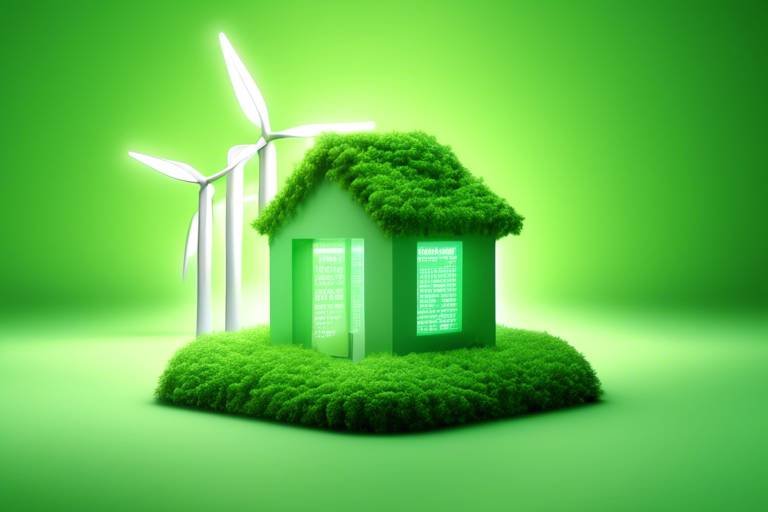Learn How to Make the Most Out Of Green Energy
In today's world, where climate change is becoming increasingly urgent, the shift towards green energy is not just a trend; it's a necessity. But how can you, as an individual or a business, truly maximize the benefits of these renewable energy sources? The answer lies in understanding what green energy is, exploring the various types available, and implementing practical solutions that can lead to a more sustainable future.
Green energy refers to energy derived from natural sources that replenish themselves over short periods of time. Unlike fossil fuels, which release harmful emissions and are finite, green energy offers a cleaner alternative that has minimal environmental impact. This is crucial in our fight against climate change, as it helps reduce our carbon footprint and promotes a healthier planet. Imagine a world where our energy needs are met without depleting the Earth’s resources—this is the promise of green energy.
There are several types of green energy sources, each with unique benefits and applications. Let's explore these options:
- Solar Energy: Captured from the sun, solar energy is harnessed using photovoltaic cells. It's one of the most accessible forms of green energy for both residential and commercial use.
- Wind Energy: Generated by wind turbines, wind energy captures the kinetic energy of wind. It’s incredibly efficient and has a low environmental impact.
- Hydro Energy: This involves generating electricity from flowing water, typically through dams. It’s a reliable source of energy but can have environmental implications on aquatic ecosystems.
- Geothermal Energy: Utilizing heat from within the Earth, geothermal energy can provide a steady and sustainable energy source, especially in volcanic regions.
Solar energy is one of the most popular green energy sources available today. By installing solar panels on rooftops, homeowners can harness sunlight to generate electricity, significantly reducing their reliance on traditional energy sources. The installation process has become increasingly affordable and efficient, making it a viable option for many. Moreover, with advancements in technology, solar panels can now be integrated seamlessly into building designs, making them not just functional but also aesthetically pleasing.
Wind energy is another powerhouse in the realm of green energy. Wind turbines, often seen dotting the landscape, convert wind's kinetic energy into electricity. Investing in wind energy solutions can be as simple as participating in community wind projects or purchasing renewable energy credits. The technology behind wind farms is constantly evolving, making wind energy more accessible and efficient than ever before.
Transitioning to green energy comes with a plethora of benefits. Not only does it contribute to a healthier environment, but it can also lead to significant cost savings. By reducing reliance on fossil fuels, individuals and businesses can lower their energy bills while simultaneously decreasing their carbon footprints. It's a win-win situation!
Implementing green energy solutions can lead to substantial cost savings over time. For instance, while the initial investment in solar panels or wind turbines may seem daunting, the long-term reduction in energy expenses can be significant. Many homeowners report savings of hundreds to thousands of dollars annually, thanks to lower utility bills and government incentives.
The shift to green energy has a profoundly positive effect on the environment. By reducing greenhouse gas emissions, renewable energy sources contribute to cleaner air and a more stable climate. This shift not only benefits the planet but also promotes biodiversity and protects ecosystems from the damaging effects of pollution.
Integrating green energy solutions into your daily life doesn’t have to be overwhelming. Here are some practical steps you can take:
Conducting an energy audit is a great first step to understanding your energy consumption patterns. This process involves evaluating your home or business to identify areas where energy efficiency can be improved. By pinpointing energy hogs, you can make informed decisions about where to invest in green technologies.
Many governments offer incentives for adopting green energy solutions. These can include grants, tax credits, and rebates that make the transition to renewable energy more affordable. Researching available programs in your area can help you take full advantage of these opportunities.
- What is green energy? Green energy is derived from renewable sources that have minimal environmental impact, such as solar, wind, and hydro.
- How can I start using green energy? You can start by conducting an energy audit, investing in solar panels, or participating in community wind projects.
- Are there financial incentives for using green energy? Yes, many governments offer grants and tax credits to encourage the adoption of renewable energy solutions.

Understanding Green Energy
Green energy refers to renewable energy sources that have minimal environmental impact, making them a crucial part of our fight against climate change. Unlike fossil fuels, which release harmful greenhouse gases when burned, green energy sources offer a cleaner and more sustainable alternative. By understanding what constitutes green energy, we can appreciate its significance in creating a healthier planet for future generations.
So, what exactly falls under the umbrella of green energy? It includes sources like solar, wind, hydro, and geothermal energy. Each of these sources harnesses natural processes to generate electricity or heat, thereby reducing our reliance on non-renewable resources. For instance, solar panels convert sunlight directly into electricity, while wind turbines capture the kinetic energy of wind. This transformation is not just revolutionary; it's essential for a sustainable future.
One of the most compelling aspects of green energy is its potential to reduce our carbon footprint. By shifting to renewable energy sources, individuals and businesses can significantly lower their greenhouse gas emissions. In fact, studies show that transitioning to green energy can cut emissions by up to 70% in some regions. This staggering statistic highlights the importance of adopting green practices. Every little bit counts, and when we come together as a community, the impact can be monumental.
Moreover, green energy is not just about environmental benefits; it also promotes energy independence. Many countries rely heavily on imported fossil fuels, which can be subject to volatile market prices and geopolitical tensions. By investing in local renewable energy sources, nations can reduce their dependence on foreign energy, leading to greater economic stability and security. Imagine a world where energy is abundant, clean, and locally sourced—this is the future we can create with green energy.
In summary, understanding green energy is the first step towards embracing a sustainable lifestyle. It involves recognizing the various sources of renewable energy and their profound impact on our environment and economy. As we delve deeper into the different types of green energy sources in the following sections, keep in mind that each choice we make can lead us closer to a greener, more sustainable future.
- What is green energy? Green energy refers to energy derived from renewable sources that have a minimal impact on the environment.
- How does green energy help combat climate change? By reducing greenhouse gas emissions and reliance on fossil fuels, green energy helps mitigate climate change effects.
- What are the main sources of green energy? The primary sources include solar, wind, hydro, and geothermal energy.
- Can I install green energy solutions in my home? Yes, many homeowners can install solar panels or wind turbines to harness green energy.

Types of Green Energy Sources
When it comes to green energy, there’s a vibrant palette of options to choose from, each with its unique characteristics and benefits. Understanding these sources is crucial for anyone looking to make informed decisions about their energy consumption. So, let’s dive into the world of renewable energy and explore the most prominent types that are not just reshaping our energy landscape but also paving the way for a more sustainable future.
The four primary types of green energy sources include solar, wind, hydro, and geothermal. Each type harnesses natural processes to generate energy, minimizing environmental impact and contributing to a healthier planet. Let’s break them down:
Solar energy is perhaps the most well-known of the green energy sources. It captures sunlight using photovoltaic cells, converting it into electricity. The beauty of solar energy lies in its accessibility; anyone with a roof can potentially harness it. Not only does it reduce reliance on fossil fuels, but it also leads to significant savings on energy bills. Imagine turning your home into a mini power plant! By installing solar panels, you can generate your own electricity and even sell excess energy back to the grid. The installation process has become more affordable and efficient over the years, making it a viable option for both residential and commercial properties.
Wind energy is another powerhouse in the green energy sector. It captures the kinetic energy from wind through turbines, which convert it into electricity. Wind farms, often found in open fields or offshore, are a testament to the potential of this energy source. The technology behind wind turbines has advanced significantly, allowing for greater efficiency and output. But what if you’re not ready to invest in a wind farm? There are smaller-scale solutions, like residential wind turbines, which can also provide substantial energy savings. Just think of the wind as nature’s way of generating power without leaving a footprint!
Hydro energy, or hydropower, utilizes flowing water to generate electricity. This can be achieved through large dams or small run-of-the-river systems. The force of water spinning turbines creates energy, making it one of the most efficient energy sources available. However, it’s essential to consider the ecological impacts of large dams, as they can disrupt local ecosystems. That’s why many are looking towards smaller, more sustainable hydro solutions that provide clean energy without the environmental trade-offs.
Geothermal energy taps into the Earth’s internal heat. This energy source is particularly effective in regions with high volcanic activity, where heat from the Earth’s core can be accessed. By drilling deep into the ground, we can harness steam or hot water to produce electricity or heat buildings. It’s like having a natural heater right beneath our feet! While the initial setup can be costly, the long-term benefits and low operational costs make it an attractive option for sustainable energy.
In summary, each of these green energy sources plays a pivotal role in our transition towards a more sustainable future. By understanding the strengths and applications of solar, wind, hydro, and geothermal energy, individuals and businesses can make informed choices that not only benefit their wallets but also contribute to the health of our planet.
- What is green energy? Green energy refers to renewable energy sources that have minimal environmental impact, such as solar, wind, hydro, and geothermal energy.
- How can I switch to green energy? You can switch to green energy by installing renewable energy systems like solar panels or wind turbines, or by choosing a green energy provider.
- Are there financial incentives for using green energy? Yes, many governments offer grants, tax credits, and other incentives to encourage the adoption of renewable energy solutions.
- What are the environmental benefits of green energy? Green energy reduces greenhouse gas emissions, decreases reliance on fossil fuels, and helps combat climate change.

Solar Energy
is one of the most abundant and accessible forms of renewable energy available today. By harnessing the power of the sun through photovoltaic cells, we can convert sunlight into electricity, making it a vital player in our quest for sustainable energy solutions. Imagine a world where rooftops are adorned with solar panels, soaking up rays and turning them into clean energy. It's not just a dream; it's a reality that’s gaining momentum!
The advantages of solar energy are numerous and compelling. For starters, solar panels can drastically reduce your electricity bills. Once installed, they require minimal maintenance and can provide free energy for decades. Depending on where you live, you might even generate enough surplus energy to sell back to the grid, transforming your home into a mini power plant. Isn’t that a fantastic way to contribute to the community while also saving money?
When considering solar energy for your home or business, the installation process is a crucial aspect. It typically begins with a site assessment, where professionals evaluate your roof’s orientation, shading, and structural integrity. After that, they design a system tailored to your energy needs. Most installations take just a few days, and before you know it, you’re tapping into a renewable energy source that’s as reliable as the sun itself. And let’s not forget about the environmental benefits—solar energy systems help reduce greenhouse gas emissions and reliance on fossil fuels, contributing to a cleaner planet.
To give you a clearer picture of how solar energy can impact your life, consider the following table that outlines the key benefits:
| Benefit | Description |
|---|---|
| Cost Savings | Reduces electricity bills and can provide income through net metering. |
| Environmental Impact | Decreases reliance on fossil fuels, reducing carbon footprint. |
| Energy Independence | Less dependency on the grid, providing security against energy price fluctuations. |
| Low Maintenance | Solar panels require minimal upkeep, making them convenient long-term investments. |
Now, you might be wondering how to effectively utilize solar panels in your residential or commercial settings. First, consider the orientation of your solar panels; ideally, they should face south to capture the most sunlight. Additionally, keeping them clean and free from debris will maximize their efficiency. Investing in a solar battery storage system can also be a game changer, allowing you to store excess energy generated during sunny days for use during cloudy periods or at night.
In conclusion, solar energy is not just a trend; it’s a sustainable lifestyle choice that benefits both your wallet and the environment. By embracing solar energy, you are not only reducing your carbon footprint but also paving the way for a greener future. So, why not take the plunge? The sun is shining, and it’s time to harness its power!
Q: How long do solar panels last?
A: Most solar panels come with a warranty of 25 years, but they can last much longer with proper maintenance.
Q: Can solar panels work in cloudy weather?
A: Yes, solar panels can still generate electricity on cloudy days, although their efficiency may be reduced.
Q: What is net metering?
A: Net metering is a billing mechanism that credits solar energy system owners for the electricity they add to the grid.
Q: How much do solar panels cost?
A: The cost can vary widely based on the system size and location, but many homeowners see a return on investment within 5 to 10 years.

Wind Energy
Wind energy is one of the most promising and rapidly growing sources of renewable energy available today. By capturing the kinetic energy produced by moving air, wind turbines convert this natural force into electricity, providing a clean and sustainable power source. But how does this process work, and what makes wind energy such an attractive option for both individuals and businesses? Let's dive deeper into the world of wind energy.
At its core, wind energy is harnessed through the use of wind turbines, which are designed to capture the wind's energy and convert it into usable electricity. These turbines can be found in various settings, from large wind farms that span vast landscapes to smaller, localized installations that serve individual homes or businesses. The technology behind wind energy has advanced significantly over the years, making it more efficient and accessible than ever before.
One of the key benefits of wind energy is its environmental impact. Unlike fossil fuels, which release harmful greenhouse gases into the atmosphere, wind energy is a clean source of power that produces no emissions during operation. This means that by investing in wind energy, individuals and businesses can significantly reduce their carbon footprint and contribute to a healthier planet. In fact, according to the U.S. Department of Energy, wind power has the potential to reduce carbon dioxide emissions by up to 80 million metric tons annually!
Moreover, wind energy can also lead to substantial cost savings. The initial investment in wind turbines may seem daunting, but the long-term savings on energy bills can be quite significant. Once installed, wind turbines have low operating costs and can generate electricity at competitive prices. In many regions, wind energy is already one of the cheapest sources of electricity available. For instance, a recent study showed that the levelized cost of wind energy has dropped by over 70% in the past decade, making it an economically viable option for many households and businesses.
For those looking to invest in wind energy solutions, there are several options available:
- Community Wind Projects: These initiatives allow multiple stakeholders to invest in a shared wind farm, spreading the costs and benefits among participants.
- Residential Wind Turbines: Homeowners can install small-scale wind turbines on their properties to generate electricity for personal use.
- Power Purchase Agreements (PPAs): Businesses can enter into agreements to purchase wind energy directly from producers, ensuring a stable and often lower energy cost.
In conclusion, wind energy represents a powerful opportunity for a sustainable energy future. By harnessing the wind, we can create a cleaner environment, save money on energy costs, and contribute to a more resilient energy grid. Whether you're an individual looking to reduce your energy bills or a business aiming to enhance your sustainability efforts, wind energy is a viable and impactful solution worth considering.
Q: How do wind turbines work?
A: Wind turbines convert the kinetic energy of wind into mechanical energy, which is then transformed into electricity through a generator. The blades of the turbine capture the wind's energy, causing them to rotate and drive the generator.
Q: Are wind turbines noisy?
A: Modern wind turbines are designed to operate quietly. While there may be some noise generated by the blades cutting through the air, it is generally minimal compared to other sources of noise pollution.
Q: What is the lifespan of a wind turbine?
A: Typically, wind turbines have a lifespan of about 20 to 25 years, after which they may require significant maintenance or replacement.
Q: Can wind energy be stored for later use?
A: Yes, wind energy can be stored using various methods, such as batteries or pumped hydro storage, allowing for electricity to be used even when the wind isn’t blowing.

Benefits of Using Green Energy
Transitioning to green energy is not just a trend; it’s a lifestyle choice that brings with it a plethora of benefits. Imagine a world where your energy consumption doesn’t contribute to climate change but instead helps heal our planet. The benefits of adopting renewable energy sources extend beyond just the environment; they also touch on economic factors, personal health, and energy independence. So, what exactly are these benefits?
First off, let’s talk about the environmental impact. Green energy sources, such as solar, wind, and hydroelectric power, produce minimal to no greenhouse gas emissions. This is crucial in the fight against global warming. According to the Environmental Protection Agency, energy production is one of the largest sources of greenhouse gas emissions. By switching to renewable energy, we can significantly reduce our carbon footprints and contribute to a healthier planet. Imagine if every household made this switch—what a difference it would make!
Next up is the economic advantage. While the initial investment in green energy solutions like solar panels or wind turbines might seem daunting, the long-term savings are undeniable. Here’s how:
| Investment Type | Initial Cost | Long-term Savings |
|---|---|---|
| Solar Panels | $15,000 | $30,000 over 20 years |
| Wind Turbines | $50,000 | $100,000 over 20 years |
As you can see, the upfront costs can be recouped over time through lower energy bills. Plus, many governments offer tax credits and incentives to help offset these initial expenses, making it even more appealing to make the switch.
Another significant benefit is energy independence. By utilizing green energy sources, individuals and businesses can reduce their reliance on fossil fuels, which are often subject to volatile market prices. Imagine waking up one day to find that your energy costs have skyrocketed due to global events. By investing in renewable energy, you can shield yourself from such fluctuations. You’ll have the power—literally and figuratively—to control your energy consumption.
Lastly, let’s not forget about the health benefits. Traditional energy sources like coal and natural gas release harmful pollutants into the air, contributing to respiratory issues and other health problems. In contrast, green energy sources are much cleaner. By reducing air pollution, we not only improve our health but also the health of future generations. It’s like giving the gift of clean air to our children and grandchildren.
In summary, the benefits of using green energy are multifaceted. From environmental impact to economic savings, energy independence, and health improvements, making the switch is a win-win situation. So, why not take the plunge? The future is green, and the time to act is now!
- What is green energy? Green energy refers to renewable energy sources that have a minimal environmental impact, such as solar, wind, and hydroelectric power.
- How can I transition to green energy? You can start by conducting an energy audit, researching renewable energy options available in your area, and looking into government incentives.
- Are there financial incentives for switching to green energy? Yes, many governments offer tax credits, grants, and subsidies to help offset the costs of renewable energy investments.
- Can green energy really save me money? Absolutely! While the initial investment may be high, the long-term savings on energy bills can be significant.

Cost Savings
Implementing green energy solutions is not just about making a positive impact on the environment; it's also a fantastic way to save money in the long run. Imagine slashing your energy bills while contributing to a cleaner planet! Sounds like a win-win, right? The truth is, transitioning to renewable energy sources like solar and wind can lead to significant cost reductions that many homeowners and businesses are beginning to realize.
One of the most compelling aspects of green energy is the initial investment. Yes, upfront costs can be daunting—installing solar panels or wind turbines does require some capital. However, it's essential to view this as a long-term investment rather than just an expense. Over time, the savings on your energy bills can far outweigh the initial costs. For example, a typical solar panel system can pay for itself in as little as 5 to 7 years, depending on your location and energy usage. After that, it's like having a free ride on the energy highway!
Moreover, many states and local governments offer incentives and rebates that can significantly lower the cost of installation. These programs are designed to encourage the adoption of renewable energy, making it more accessible for everyone. For instance, some homeowners have reported savings of up to 30% on their solar panel installation costs thanks to government incentives. This financial assistance can make a substantial difference, allowing more people to join the green energy revolution.
Here’s a quick look at how green energy can lead to cost savings:
| Green Energy Source | Potential Savings | Payback Period |
|---|---|---|
| Solar Energy | Up to 30% on energy bills | 5-7 years |
| Wind Energy | Variable; depends on wind availability | 5-10 years |
| Geothermal Energy | 30-60% on heating/cooling costs | 2-10 years |
In addition to energy savings, many businesses are discovering that adopting green energy solutions can enhance their brand image and attract customers who prioritize sustainability. This shift in consumer behavior means that businesses can not only save on operational costs but also potentially increase their revenue by appealing to environmentally conscious customers.
It's important to remember that the transition to green energy isn't just about saving money; it's about investing in a sustainable future. By reducing reliance on fossil fuels, we can help stabilize energy prices and protect ourselves from the volatility of traditional energy markets. So, why not take the leap? The financial benefits are just the cherry on top of a much larger pie of environmental responsibility.
- What are the initial costs associated with switching to green energy?
The initial costs can vary widely depending on the type of renewable energy system you choose. Solar panels, for example, can range from $15,000 to $30,000 before incentives, but many find that the long-term savings make it worthwhile.
- How long does it take to see savings from green energy?
Most homeowners start seeing savings within 5 to 10 years after installation, depending on the energy source and local energy prices.
- Are there government incentives available for green energy?
Yes! Many states and local governments offer rebates, tax credits, and other incentives to help offset the costs of installing renewable energy systems.

Environmental Impact
The shift to green energy is not just a trend; it's a crucial step towards preserving our planet for future generations. By embracing renewable energy sources, we can significantly reduce our carbon footprint and combat the dire effects of climate change. Imagine a world where the air is cleaner, the water is purer, and our ecosystems are thriving—this is the promise that green energy holds.
One of the most compelling aspects of green energy is its ability to drastically lower greenhouse gas emissions. Traditional energy sources, like coal and natural gas, are notorious for releasing carbon dioxide and other harmful pollutants into the atmosphere. In contrast, renewable sources such as solar, wind, and hydroelectric power produce little to no emissions during operation. This transition is akin to swapping out a rusty old car for a sleek, electric model that purrs quietly while zooming down the highway—both efficient and environmentally friendly.
To put things into perspective, consider the following statistics that illustrate the environmental benefits of renewable energy:
| Energy Source | Annual CO2 Emissions (per MWh) |
|---|---|
| Coal | 900 kg |
| Natural Gas | 400 kg |
| Wind | 11 kg |
| Solar | 20 kg |
| Hydroelectric | 30 kg |
As you can see from the table above, the difference is staggering. Transitioning to wind or solar energy can reduce emissions by over 90% compared to coal! This shift not only contributes to cleaner air but also mitigates health risks associated with pollution, such as respiratory diseases and heart conditions. It’s like trading in processed foods for fresh fruits and vegetables—your body thanks you for making the healthier choice.
Moreover, the environmental impact of green energy extends beyond just emissions. Renewable energy sources help to preserve our natural resources and biodiversity. For instance, by reducing our reliance on fossil fuels, we can protect ecosystems that are often disrupted by drilling and mining activities. The preservation of forests, wetlands, and oceans is vital for maintaining the delicate balance of our planet's biodiversity. When we choose green energy, we are not just choosing a cleaner future; we are also choosing to protect the habitats of countless species.
In summary, the environmental impact of transitioning to green energy is profound. By adopting renewable energy solutions, we can:
- Significantly lower greenhouse gas emissions
- Improve air and water quality
- Protect ecosystems and biodiversity
- Reduce health risks associated with pollution
Every small step we take towards green energy is a giant leap for our planet. It’s not just about saving money or conserving energy; it’s about creating a sustainable future for ourselves and generations to come. So, let’s embrace green energy and make a conscious choice to protect our beautiful Earth!
Q1: What is green energy?
A1: Green energy refers to renewable energy sources that have minimal environmental impact, such as solar, wind, hydro, and geothermal energy.
Q2: How does green energy help combat climate change?
A2: By reducing greenhouse gas emissions associated with traditional fossil fuels, green energy helps to mitigate the effects of climate change and promotes a healthier planet.
Q3: What are some benefits of using green energy?
A3: Benefits include lower energy bills, reduced carbon footprints, improved air quality, and the preservation of natural habitats.
Q4: How can I transition to green energy?
A4: You can start by conducting an energy audit, investing in renewable energy solutions like solar panels, and taking advantage of government incentives for green energy adoption.

How to Implement Green Energy Solutions
Transitioning to green energy is not just a trend; it's a necessity for a sustainable future. Whether you're a homeowner looking to reduce your energy bills or a business aiming to enhance your corporate responsibility, implementing green energy solutions can be a game-changer. But how do you get started? Here are some practical steps that can guide you through this exciting journey.
First and foremost, conducting an energy audit is crucial. This process involves assessing your current energy consumption to pinpoint areas where you can improve efficiency. Think of it as a health check-up for your energy use! By identifying where you’re wasting energy, you can make informed decisions about which green solutions will have the most impact. You can either hire a professional to do this or tackle it yourself by using online tools and resources. The insights gained from an energy audit can lead to significant savings and a clearer path to adopting renewable energy sources.
Next, consider the government incentives available for green energy solutions. Many governments worldwide are offering grants, tax credits, and rebates to encourage the adoption of renewable energy. These incentives can significantly reduce the upfront costs of installing solar panels, wind turbines, or other green technologies. For instance, in the United States, the federal solar tax credit allows homeowners to deduct a significant percentage of their solar installation costs from their federal taxes. Researching local programs can unveil opportunities that might just make your green energy dreams a reality.
In addition to financial incentives, think about how you can integrate green energy into your daily life. This could mean installing solar panels on your roof, investing in energy-efficient appliances, or even participating in community solar programs. By choosing products that are designed with sustainability in mind, you can contribute to a larger movement towards eco-friendliness. For example, if you’re interested in solar energy, many companies offer leasing options that require little to no upfront costs, making it easier to embrace this clean energy source.
Moreover, engaging with your community can amplify your efforts. Join local environmental groups or participate in workshops about renewable energy. Sharing experiences and solutions with like-minded individuals can provide you with valuable insights and motivation. Remember, the shift towards green energy is not just an individual effort; it's a collective movement that thrives on collaboration and shared knowledge.
To further illustrate the potential benefits of implementing green energy solutions, consider the following table that outlines the key advantages:
| Green Energy Solution | Benefits |
|---|---|
| Solar Energy | Reduces electricity bills, low maintenance costs, and increases property value. |
| Wind Energy | Provides a sustainable energy source, low operational costs, and can be used in remote areas. |
| Geothermal Energy | Offers consistent energy supply, low emissions, and reduces heating and cooling costs. |
| Hydropower | Generates large amounts of electricity, low operational costs, and supports local ecosystems. |
In conclusion, implementing green energy solutions is not just an option; it's an essential step towards a sustainable future. By conducting energy audits, taking advantage of government incentives, and engaging with your community, you can make a significant impact. Every small change adds up, and together we can create a cleaner, greener world for future generations.
- What is an energy audit? An energy audit is an assessment of your home's energy use to identify areas for improvement.
- Are there any financial incentives for going green? Yes, many governments offer tax credits, rebates, and grants for adopting renewable energy solutions.
- How can I start using solar energy? You can start by researching local solar providers, considering solar leasing options, or participating in community solar programs.
- What are the benefits of renewable energy? Renewable energy reduces greenhouse gas emissions, lowers energy bills, and contributes to a healthier planet.

Energy Audits
When it comes to maximizing the efficiency of your energy consumption, conducting an energy audit is an essential first step. Think of it as a health check-up for your home or business's energy use. Just like you would visit a doctor to assess your health, an energy audit helps pinpoint areas where you can improve your energy efficiency and reduce waste. So, how does one go about this? It's simpler than you might think!
An energy audit typically involves a thorough examination of your property. This can include checking insulation levels, evaluating heating and cooling systems, and inspecting appliances. The goal is to identify where energy is being lost and suggest practical solutions to enhance efficiency. For instance, did you know that up to 30% of your heating and cooling costs can be attributed to air leaks? By sealing these leaks, you can save a significant amount on your energy bills!
There are generally two types of energy audits: DIY audits and professional audits. A DIY audit can be a great starting point for homeowners wanting to save a few bucks. It usually involves simple steps like checking for drafts, inspecting your insulation, and evaluating your lighting. On the other hand, a professional energy audit, while more expensive, provides a comprehensive analysis of your energy use. Professionals use specialized equipment, such as blower doors and infrared cameras, to detect issues that might not be visible to the naked eye.
Here’s a quick breakdown of what you can expect during a professional energy audit:
| Audit Phase | Description |
|---|---|
| Initial Assessment | The auditor will gather information about your energy bills and discuss your energy concerns. |
| Inspection | A thorough examination of your property, including insulation, windows, and appliances. |
| Testing | Using specialized tools to measure air leakage and evaluate heating/cooling systems. |
| Report | The auditor will provide a detailed report with recommendations for improvements. |
After the audit, you’ll receive a detailed report that outlines the findings and offers tailored recommendations. This could include suggestions for upgrading to energy-efficient appliances, improving insulation, or even investing in renewable energy sources. Not only will these changes help you save money, but they will also contribute to a more sustainable future.
In conclusion, conducting an energy audit is not just about cutting costs; it’s about taking a proactive step towards a greener lifestyle. By understanding your energy consumption patterns, you can make informed decisions that benefit both your wallet and the planet. So, why wait? Take that first step toward energy efficiency today!
- What is an energy audit? An energy audit is an assessment of how energy is used in a home or business, identifying areas for improvement to enhance efficiency.
- How often should I conduct an energy audit? It's recommended to conduct an energy audit every few years or whenever you make significant changes to your property.
- Can I perform an energy audit myself? Yes, a DIY audit is possible and can be a good starting point, but a professional audit provides a more comprehensive analysis.
- What are the benefits of an energy audit? Benefits include reduced energy bills, improved comfort, and a lower carbon footprint.

Government Incentives
Government incentives play a crucial role in facilitating the transition to green energy solutions. These incentives are designed to encourage individuals and businesses to adopt renewable energy technologies by making them more financially accessible. Imagine being able to harness the power of the sun or wind without breaking the bank! That's where these incentives come into play, providing a financial cushion that can significantly offset initial costs.
In many countries, various programs exist to support the adoption of green energy. These can include grants, tax credits, and subsidies that reduce the upfront investment required for solar panels, wind turbines, and other renewable energy technologies. For instance, a homeowner looking to install solar panels may qualify for a tax credit that could cover a substantial portion of the installation cost. This not only makes the investment more appealing but also accelerates the shift towards sustainable energy practices.
To give you a clearer picture, here's a
| Type of Incentive | Description | Example |
|---|---|---|
| Grants | Direct financial assistance that does not need to be repaid. | State-funded grant for solar panel installation. |
| Tax Credits | Reductions in the amount of tax owed based on renewable energy investments. | Federal tax credit for installing solar energy systems. |
| Subsidies | Financial assistance provided to help lower the cost of renewable energy technologies. | Government subsidies for wind energy projects. |
Additionally, many local governments offer incentive programs tailored to their specific regions. These programs can vary widely, so it's essential to research what is available in your area. For example, some municipalities may provide rebates for energy-efficient appliances or offer reduced property taxes for homes that utilize renewable energy sources. These local initiatives can make a significant difference, especially when combined with federal incentives.
Furthermore, the landscape of government incentives is continually evolving. As climate change becomes an increasingly pressing issue, more governments are implementing policies to encourage green energy adoption. Staying informed about these changes can help you take advantage of new opportunities as they arise. It’s like having a treasure map; the more you know, the easier it is to find the hidden gems that can save you money and contribute to a healthier planet.
In conclusion, taking advantage of government incentives is a smart strategy for anyone considering a move towards green energy. Not only do these incentives make renewable energy solutions more affordable, but they also support the broader goal of reducing carbon emissions and promoting sustainability. So, whether you're a homeowner looking to install solar panels or a business aiming to invest in wind energy, don't overlook the potential benefits of these programs!
- What types of government incentives are available for green energy?
Incentives can include grants, tax credits, and subsidies, all aimed at reducing the cost of renewable energy installations. - How can I find out what incentives are available in my area?
Research your local government’s website or consult with renewable energy providers to learn about available programs. - Do government incentives apply to both residential and commercial projects?
Yes, many incentives are available for both residential and commercial renewable energy projects.
Frequently Asked Questions
- What is green energy?
Green energy refers to renewable energy sources that are environmentally friendly and have a minimal negative impact on the planet. This includes energy generated from sources like solar, wind, hydro, and geothermal. By utilizing these resources, we can significantly reduce our carbon footprint and combat climate change.
- How can I benefit from using solar energy?
Solar energy can lead to substantial savings on your electricity bills, especially in sunny areas. By installing solar panels, you can harness sunlight to generate your own electricity, reducing reliance on traditional power sources. Additionally, many governments offer incentives and tax credits for solar installations, further enhancing the financial benefits.
- What are the main types of green energy sources?
The main types of green energy sources include:
- Solar Energy: Captured from sunlight using photovoltaic cells.
- Wind Energy: Generated by wind turbines that convert wind's kinetic energy into electricity.
- Hydro Energy: Produced from flowing water, typically through dams.
- Geothermal Energy: Harnessed from the Earth's internal heat.
- What are the environmental benefits of switching to green energy?
Switching to green energy significantly reduces greenhouse gas emissions, which are a major contributor to global warming. By using renewable resources, we help protect ecosystems, improve air quality, and promote a healthier planet for future generations.
- How can I implement green energy solutions in my home?
Implementing green energy solutions can be as simple as conducting an energy audit to identify areas for improvement. You can also consider installing solar panels, utilizing energy-efficient appliances, and taking advantage of government incentives to support your transition to renewable energy sources.
- Are there any government incentives for adopting green energy?
Yes, many governments offer various incentives to encourage the adoption of green energy solutions. These can include tax credits, grants, and rebates for installing renewable energy systems, making it more affordable for individuals and businesses to make the switch.
- Can businesses benefit from green energy?
Absolutely! Businesses can save significantly on energy costs by investing in green energy solutions. Furthermore, adopting renewable energy practices can enhance a company's reputation, attract eco-conscious customers, and comply with regulatory requirements regarding sustainability.

